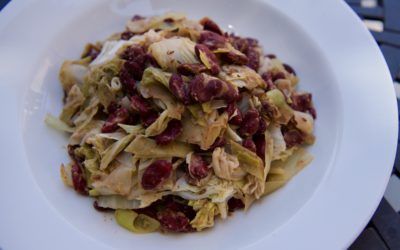Plant-Based Side Dish Recipes
Although side dishes are usually considered enhancements to the main dish, when you eat a healthy diet, they can be the central attraction. They are faster and simpler to make than entrees, which means you can cook and eat several of them and thereby have a wider variety when you sit down for a meal.
They’re also great toppers for plain starches, such as steamed rice, potatoes, or quinoa, and add color and texture to many dishes. Have you heard the saying “eat the rainbow”? This is where you make it happen, as many plant-based ingredients come in a dazzling array of colors.
Braised Red Cabbage with Dried Cherries
The dish is evocative of sauerkraut but with a sweet touch from the cherries.
Steamed Asparagus and Artichoke Hearts
For a nicer presentation and mouthfeel, peel the asparagus. This will remove the chewy, fibrous skin, leaving the asparagus soft and tender. It’s important to serve this dish as soon as it’s finished cooking; otherwise, the asparagus will turn a funky green color.
Baby Bok Choy and Macadamias
Baby bok choy doesn’t grow up to be regular bok choy; these are actually two different vegetables. However, you can substitute one for the other. The flavor of baby bok choy is just a tad milder than its big brother, and its leaves are more tender.
Orange-Braised Fennel
Fennel is one of the most versatile vegetables around. From raw to roasted and everything in between, fennel can delight your palate in many different ways.
Indian-Spiced Baked Beans
Spices benefit greatly by being toasted prior to cooking with them in order to bring out their flavor and aroma. Whole spices will almost always have more flavor if you grind them yourself than if you purchase them already ground.
Caraway-Mustard Kidney Beans
Sometimes naughty food can inspire healthy dishes. This one is based on the flavors of the traditional reuben sandwich. The key ingredients are caraway seeds, for their distinctive flavor, cabbage and mustard, which stand in for the sauerkraut, and kidney beans for the reddish protein. The takeaway? You don’t have to reinvent the wheel to create healthy food––you just have to point it in the right direction.
Wild Rice and Spinach
The wild rice for this recipe can be cooked a day or two in advance. If it’s cooked the same day you’ll be serving it, this salad will have a softer texture.
Roasted-Garlic Mashed Potatoes
The secret to fluffy mashed potatoes is mixing them as soon as they’re done steaming. If they’re allowed to cool down, they’ll become gummy. If you really love garlic, double up on the roasted garlic cloves.
Oven-Roasted Plantain Fajitas
Plantains are in the banana family, but they are larger than regular bananas. Their starch content is much higher too, which is why they are seldom eaten raw and are usually baked, roasted, or fried. Plantains are ripe when they’re half black and half yellow. You can find fresh epazote in most Latin supermarkets.
Cilantro-Buttered Corn
The cilantro butter for this recipe is brimming with flavor. It provides a healthier alternative to the ever-popular buttery, cheesy, salty way of flavoring corn on the cob.
Mustard-Braised Brussels Sprouts and Corn
November and December are the peak months for brussels sprouts. Their flavor becomes stronger the longer they are stored, so cook them soon after purchase.
Double Squash with Pecans and Dried Cherries
This recipe combines sweet butternut squash, pecans, and cherries with savory acorn squash, shallot, and sage. The flavors complement rather than overpower each other.









